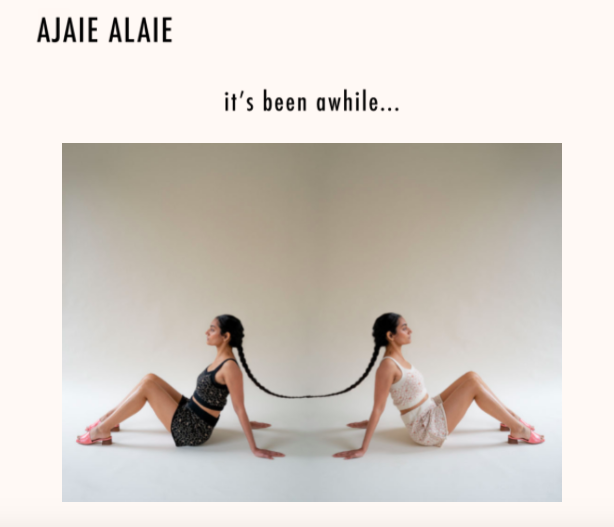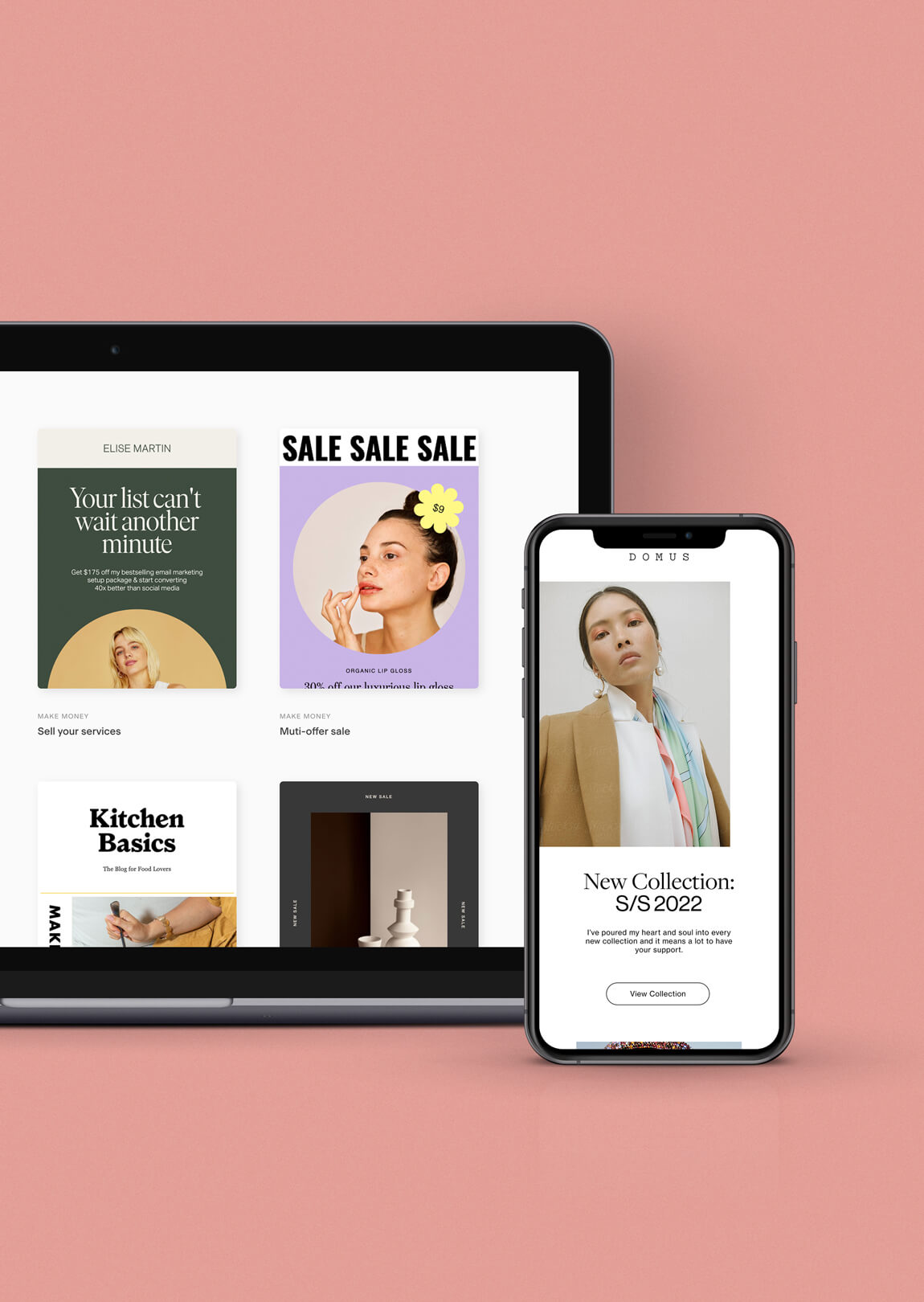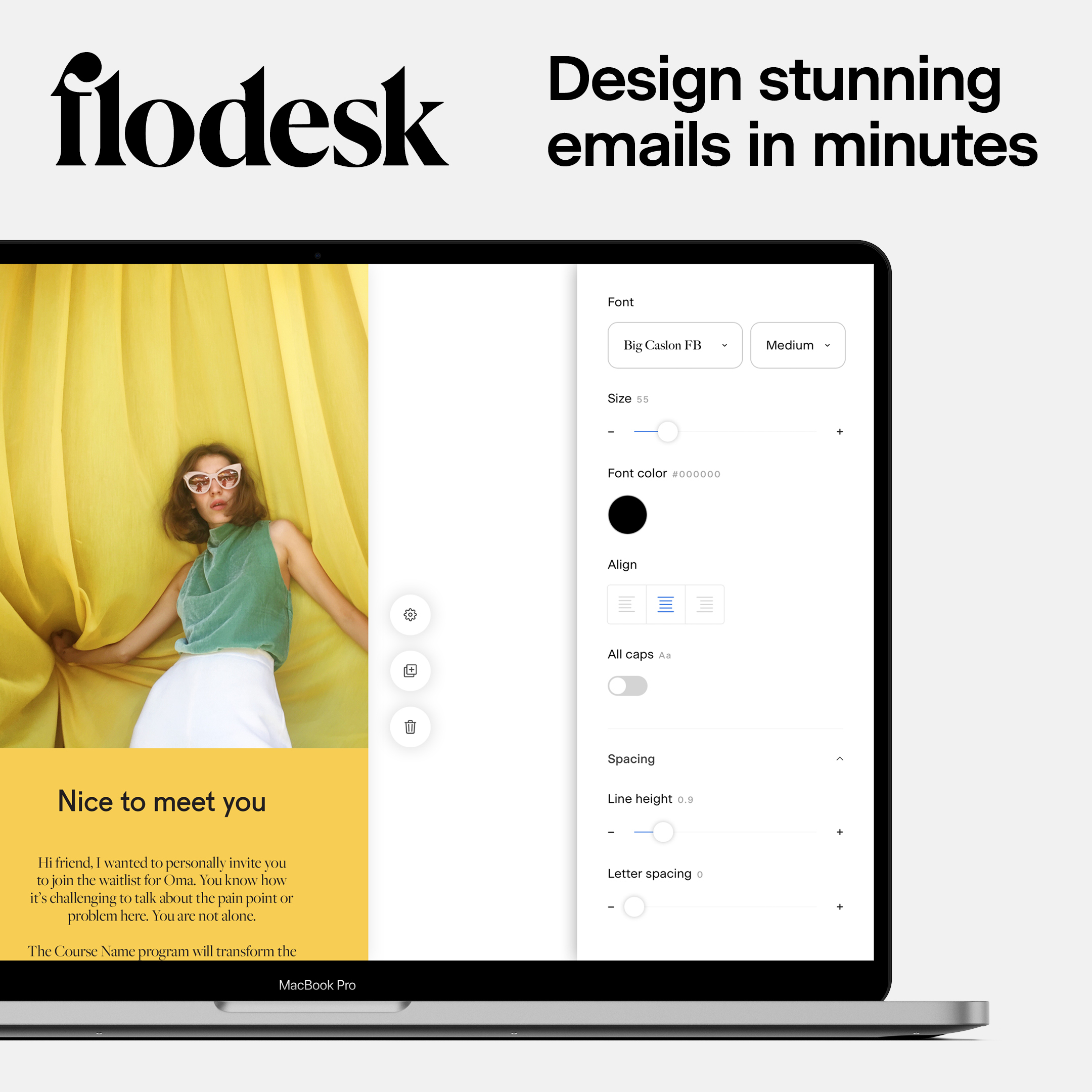How to Write a Re-Engagement Email to Win Back Lost Subscribers
Table of Contents Jump to:
Jump to:
Table of contents
Re-engaging inactive subscribers is a vital part of small business email marketing. Not only does it show your community that you care about them and have a lot of value to offer, but it’s also good business sense.
In fact, the cost of generating new leads is up to 5x more expensive than retaining existing customers. It’s also much easier to make a sale with an existing customer than a new lead.
We’ve written this comprehensive guide on how to write a re-engagement email in order to help you out with this important facet of email marketing. Keep reading to:
- Learn how to create a re-engagement email campaign
- Find out some of the common reasons why subscribers become inactive in the first place
- Consider some common dos and don’ts of re-engagement emails
- Discover Flodesk’s top re-engagement email basics
Beautiful email templates for stunning campaigns
Create effective re-engagement sequences to bring back uneganged subscribers with Flodesk.
What is a re-engagement email?
A re-engagement email is an email that’s sent to inactive or disengaged subscribers in the email marketing world. Re-engagement emails can be sent by themselves or part of large re-engagement email campaigns.
The biggest indications that you’ve got inactive subscribers on your hands include low click rates and low open rates, especially if your email metrics used to be higher and have fallen into a slump.
At one time or another, all businesses should send out re-engagement campaigns. It’s a great way of ensuring that you’ve got as many engaged subscribers as possible while cleansing your list of those who’ve lost interest or otherwise don’t need to stay subscribed.
If you’re specifically looking for re-engagement email examples to get you inspired, check out our blog post on that same topic.
Best practices for re-engagement emails
When you’re putting together your own re-engagement email campaign together, keep these basic steps in mind for optimal results.
Craft the perfect subject line
The first thing you should decide when sending out a re-engagement email is your subject line. If your subscriber hasn’t been interested in your email marketing efforts as of late, you’ll have to come up with something that grabs their attention right away.
As always, you should implement general email subject line best practices. They include:
- Make sure your subject line matches the contents of your email
- Be concise and front load with power words
- Emulate subject lines that have performed well in the past
- Mirror your customer’s voice
- Let your brand’s personality shine
- Use an emoji if it aligns with your brand (but don’t overdo it)
- Sprinkle in numbers and statistics where appropriate
Here are a few examples of re-engagement email subject lines to help get you inspired:
- It’s been a while, [insert name]!
- We miss you, [insert name], how about 15% off?
- We’re still here to help you reach your goals, [insert name]!
- Let’s check in, [insert name]. We haven’t heard from you lately!
- How can we improve, [insert name]?
- We’ve got a freebie just for you, [insert name].
Re-engage email subscribers by offering something of value
A key element of a re-engagement email campaign is offering your subscribers something of value to regain their loyalty and encourage them to stay subscribed. It’s always possible that certain subscribers have simply forgotten about your brand and need a little extra something to pique their interest once again. Use one of our product update email templates to send exciting news about a new or existing product.
One of the most common offers you’ll find in an engagement email sequence is a discount code between 10-20% for a customer’s next purchase. If you want to try something different, you can also offer a freebie or other content that’s usually ‘gated’ like an ebook or guide.
If you offer services rather than products (for example, coaching, photography, or consulting), you could also offer a free or heavily discounted session.
Clarify email preferences
As a general rule, we receive too many emails. In fact, people have as many as 200 emails in their inbox at any given time.
Owing to this, certain people want to reduce the amount of email messages they receive on a daily basis. They might not necessarily want to unsubscribe from your mailing list, but they would like to hear from you a little bit less frequently.
It’s vital to offer these kinds of subscribers the option to adjust and personalize their email marketing preferences to reduce the volume of emails they receive. That way, they’ll keep hearing from you without feeling overwhelmed or frustrated. Win-win.
Ask inactive email subscribers if they want to stay on your list
At the risk of sounding negative, it’s important to realize when you should leave an inactive subscriber alone. Of course, you should try your best with re-engagement emails, but it’s also vital to ‘let someone go’ when it’s warranted, rather than coming across as desperate.
If someone really isn’t interested in your brand, you’ll be better off putting your energy into capturing new leads who are genuinely excited about what you have to offer.
It’s never fun to lose subscribers, but it can ultimately be a good thing. Once you’ve cleansed your email list it might be a little smaller, but it’ll be full of better quality subscribers.
An engaged subscriber list will also give you a more realistic picture of your email marketing strategy success in the long term rather than worrying about low open rates and the like.
When sending out a re-engagement email campaign, make it easy for subscribers to unsubscribe if that’s what they want to do. It’s also a good idea to conclude your re-engagement campaign by genuinely asking the reader if they want to stay on your list with an obvious call-to-action.
How to create a re-engagement email campaign sequence
As mentioned, re-engagement email campaigns are often much more effective than singular re-engagement emails. They give your message more visibility and provide the space for you to cover different re-engagement strategies without sending content that’s overly long-winded.
In order to plan an ideal re-engagement email campaign, keep the following steps in mind:
Build and automate your workflows in advance with Flodesk
Flodesk workflows are the simplest way to automate your re-engagement emails to win subscribers back.
1. Create an outline for all the engagement emails you want to send
If you’ve made the decision to send out a re-engagement email campaign rather than a single message, it’s a good idea to create an outline of all the individual emails that’ll make up your campaign before you start sending.
This is a great strategy because you’ll ensure that you include all the information you want without making your messages too long or repeating yourself.
Here’s an example of the messages that could make up a great re-engagement email sequence:
- An introductory reminder email. This first re-engagement email should be light-hearted and make the reader realize they haven’t engaged with your brand in a while.
- Feedback email: Ask subscribers if there’s a reason behind their low engagement, be open to feedback and constructive criticism, and give them the opportunity to adjust email frequency.
- Promotional email: Offer your subscribers some kind of freebie, discount, or special offer to encourage them to give your brand another shot.
- Unsubscribe email: If your inactive subscriber hasn’t responded to the previous messages in your campaign, ask them if they’d like to be removed from your email list altogether.
When building a re-engagement email sequence, your life will be a lot easier if you use an email marketing platform like Flode
sk that makes building automations a breeze. Your email campaigns will always go out on time and according to how subscribers interacted with previous emails.
2. Use a professional email template that puts the focus on the content
Templates are an email marketer’s best friend. They help them save time and ensure that they send out gorgeous emails that subscribers love to see in their inbox every single time.
If you’re selecting a template for your re-engagement emails, be sure to choose one that’s minimalist, clean, and professional. That’ll keep the focus on your visuals and what you have to say. A template that comes off as too busy might be overwhelming for the reader.
If you’re looking for the perfect template for your re-engagement emails, look no further. We’ve got an extensive library of email templates and we’re passionate about great design, so you can count on your emails looking fantastic with minimal time and effort necessary to put them together.
3. Check out some re-engagement email examples
If you need help getting inspired for your re-engagement email campaign, try checking out the wealth of engagement email examples out there. Re-engagement emails can be lighthearted and fun, they don’t have to be all doom and gloom.
We’ve got an article full of different kinds of re-engagement emails on the Flodesk blog, so feel free to check out our curated re-engagement email examples.
4. Give a healthy waiting period between re-engagement emails
When sending out a re-engagement email campaign, avoid bombarding your email list with messages every day. They’ll get overwhelmed, frustrated, and maybe even unsubscribe when they wouldn’t have otherwise.
It’s important to plan for a healthy waiting period between your different re-engagement emails and send them out over a specific period of time. For example, send out an email weekly for a month rather than four emails for four days in a row.
5. Always include an unsubscribe link
Even though you don’t ideally want your subscribers to leave your list, it’s important that you include an unsubscribe link within all your re-engagement emails.
This not only makes it easy for the reader to unsubscribe if they so choose, but it’ll also ensure that you stay compliant with data protection and privacy regulations like the European GDPR.
Why your inactive customers might be tuning out
It can be difficult to determine the reason why certain subscribers have become disengaged with your email content. Here are a few of the most common reasons why.
Too many emails
It’s important to be mindful of how many emails you send out. Many people get frustrated when they feel they’re constantly receiving email campaigns from the same brand. Consider adjusting how often you send emails or ask your subscribers to adjust their own email preferences for a more customized experience.
It’s also worth noting that your problem might not be too many emails point blank. You also might be sending too many promotional or sales-focused emails that mean you need to diversify your content.
One-time or seasonal purchases
It’s possible that your subscribers have lost interest in your brand if:
- They only wanted to make a one-time purchase in the first place.
- The products or services you offer are seasonal or meant for a specific moment in a person’s life (for example, having young children).
This situation makes it a little bit trickier to put together an effective re-engagement email, but not impossible. Think about how you can pivot your sales strategy and engage your customers in a broader sense.
Email marketing content isn’t what they signed up for
This is one of the main culprits that can both negatively affect your sender reputation and cause people to tune out of your emails or even unsubscribe. If your subscribers are receiving the kind of marketing emails that they never actually signed up for, they certainly won’t be happy and will lose interest quickly.
When growing your email list, it’s important that you segment your subscribers according to the kind of content they want to receive. Don’t use leads for any and all kinds of email content under the sun: it won’t be effective, and you’ll end up with a lot of frustrated contacts on your hands.
Instead, focus on nurturing your subscribers with an email sequence that’s consistent with the kind of information they initially expressed interest in.
Old or inactive email address
This is one of the big reasons why it’s crucial to go through your email list from time to time. It’s possible that some of your subscribers are on your email list with old or inactive email addresses. That means that they might not be seeing your emails at all, so it’s a good idea to remove them from your mailing list altogether.
Emails being sent to a spam folder
It’s also possible that some of your email subscribers aren’t seeing your messages if they’re getting directed to their spam folder. There are several ways you can avoid your emails being marked as spam, including:
- Ask your subscribers to white list your email address
- Don’t use spammy or misleading subject lines
- Don’t use spammy words in your subject lines like click here, congratulations, this is not spam, winner, risk-free, or special promotion
- Monitor your sender reputation
- Stay compliant with data protection laws like the GDPR
- Check email engagement metrics like complaints and reports regularly
- Make sure your sender information is up-to-date and accurate
Create emails your subscribers love with Flodesk
Avoid the spam folder by designing the emails your subscribers can’t wait to open.
The dos and don’ts of writing a re-engagement email
Before you start writing your re-engagement emails, consider the following dos and don’ts to help guide your first steps and set you up for success.
Do
Offer inactive contacts options
Remember that it doesn’t have to be all-or-nothing with inactive subscribers. In fact, presenting the situation as an ultimatum isn’t likely to yield good results.
Re-engage customers by offering them more options than just purchasing or unsubscribing. Try suggesting that they modify their email frequency or adjust their email preferences. You can also provide high-value content to show inactive users what they’re missing before sending them a sales-focused promotion or exclusive deal.
It’s best to send a re-engagement campaign rather than a one-off email so you’ll have lots of space to provide different options to your subscribers.
Be open to conversation
It might not always be immediately clear why one of your subscribers seemingly lost interest in your email marketing content. If that turns out to be your case, keep an open mind and ask your subscribers for feedback. You can do this by integrating a poll into your re-engagement email or simply by asking them to respond to your message directly.
This is a great strategy because you’ll be able to gather genuine feedback from your subscribers and show them that you care about what they have to say.
Once you nail down why your subscriber is disengaged, you’ll be better positioned to fix that problem.
Sometimes all it takes is a little bit of one to one conversation.
Keep the mood light
Even though it might not feel good to have to re-engage inactive subscribers, it’s best to keep the mood light in your re-engagement emails. Stick with your regular brand tone and even integrate some cute imagery if it’s appropriate.
Rather than coming across as desperate to regain an inactive user, it’ll be a lot more effective if you let what made your subscriber opt in in the first place shine.
Embrace personalization
Personalization is one of the pinnacles of a successful email marketing strategy and re-engagement campaigns are no exception. However, personalization can extend far beyond subject lines and salutations.
One of the best ways you can use personalization for re-engagement is with segmentation. Divide your inactive subscribers into different segments based on why they’ve lost interest in your email marketing content. You can then create personalized emails and other re-engagement content that speaks to their specific situation.
Remind subscribers what they’re missing
Sometimes subscriber disengagement isn’t as complicated as we make it out to be. Your subscribers may have just forgotten about your brand or your emails might have gotten lost in their busy inbox.
In this context, all it takes to bring inactive subscribers back into your corner is a reminder of what they’ve been missing. After all, they subscribed to your email list in the first place for a reason.
Remind your inactive subscriber of the value your brand offers and what they’re missing out on by overlooking your email content. In order to sweeten the deal even more, you can offer them a special freebie, discount code, or promotion.
Don’t
Play the guilt card
While it’s fine to touch on emotions in re-engagement emails, it’s important not to go overboard with the guilt card. Don’t make your subscribers feel bad that they aren’t engaging with your email marketing content. Rather, focus on why they’re disengaged and work to solve that problem.
Avoid the elephant in the room
On occasion, you might be aware of the reason why certain subscribers have lost interest in your brand. Perhaps they bought a new product that wasn’t well-received. Maybe your company has been experiencing shipping problems as of late.
If you’re aware of the why behind an inactive subscriber, it’s important to face the issue head on rather than avoiding the elephant in the room. Your re-engagement emails should acknowledge the issue at hand and explain the steps your company is taking to resolve it.
Come off as spammy
While it’s a good idea to send out multiple re-engagement emails, don’t go overboard and come off as spammy.
As a general rule, limit your re-engagement email campaign to five separate messages and make sure there’s at least a few days between them all.
It’s time to win back those subscribers
As you can see, re-engagement emails are an incredibly effective way to win back subscribers and ensure that they keep receiving the content they love.
Remember, re-engagement email campaigns can vary a lot, so be sure to keep our basic tips, best practices, tips, and dos and dont’s in mind while developing yours. Above all, remember that what you create should align with your brand and let your personality shine, just like the rest of your email marketing content.
If you’re looking for an email marketing platform that will help you create an excellent re-engagement campaign, give Flodesk a try. We specialize in helping you create email marketing content your subscribers will love receiving and have a 30-day free trial you can use with no strings attached.









